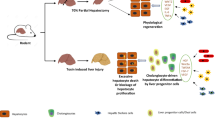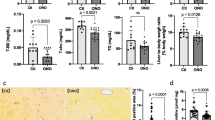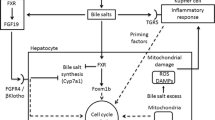Abstract
Cholestasis occurs in a wide variety of human liver diseases, and hepatocellular injury is an invariant feature of cholestasis causing liver dysfunction and inflammation, promoting fibrogenesis, and ultimately leading to liver failure. α-Melanocyte-stimulating hormone (α-MSH) is a potent anti-inflammatory agent in many models of inflammation, suggesting that it inhibits a critical step common to different forms of inflammation. The aim of this study was to investigate whether the gene transfer of α-MSH could attenuate hepatic inflammation after bile duct ligation in the rat. Studies were performed in bile duct-ligated (BDL) rats. Hydrodynamic-based gene transfection with α-MSH plasmid via rapid tail vein injection was performed 30 min after ligation of bile duct. The endpoints were studied as markers of inflammation 7 days after bile duct ligation. α-MSH expression in liver via a single administration of naked plasmid was demonstrated. Liver inflammation index, including neutrophil infiltration and serum alanine aminotransferase, were significantly reduced in α-MSH gene transfer rats. Markers for liver inflammation, including expression of tumor necrosis factor-α (TNF-α), interleukin-1β (IL-1β), and inducible NO synthase (iNOS) mRNA, as assessed by real-time PCR, were also attenuated by α-MSH gene therapy. Expression of iNOS protein in liver diminished after α-MSH gene transfer. Consistent with these data, hepatic stellate cells (HSC) and Kupffer cells were markedly inhibited in α-MSH gene-treated rats. Our findings show that gene transfer of α-MSH could attenuate hepatic inflammation after bile duct ligation in the rat.








Similar content being viewed by others
References
Trauner M, Meier PJ, Boyer JL (1998) Molecular pathogenesis of cholestasis. N Engl J Med 339:1217–1227
Greim H, Trulzsch D, Czygan P et al (1972) Mechanism of cholestasis. 6. Bile acids in human livers with or without biliary obstruction. Gastroenterology 63:846–850
Miyoshi H, Rust C, Roberts PJ et al (1999) Hepatocyte apoptosis after bile duct ligation in the mouse involves Fas. Gastroenterology 117:669–677
Chiao H, Foster S, Thomas R et al (1996) α-melanocyte-stimulating hormone reduces endotoxin-induced liver inflammation. J Clin Invest 97:2038–2044
Rajora N, Boccoli G, Catania A, Lipton JM (1997) Alpha-MSH modulates experimental inflammatory bowel disease. Peptides 18:381–385
Airaghi L, Lettino M, Manfredi MG et al (1995) Endogenous cytokine antagonists during myocardial ischemia and thrombolytic therapy. Am Heart J 130:204–211
Cannon JG, Tatro JB, Reichlin S, Dinarello CA (1986) Alpha melanocyte stimulating hormone inhibits immunostimulatory and inflammatory actions of interleukin 1. J Immunol 137:2232–2236
Rajora N, Boccoli G, Burns D et al (1997) Alpha-MSH modulates local and circulating tumor necrosis factor-alpha in experimental brain inflammation. J Neurosci 17:2181–2186
Friedman SL (2000) Molecular regulation of hepatic fibrosis, an integrated cellular response to tissue injury. J Biol Chem 275:2247–2250
Wang CH, Liang CL, Huang LT et al (2004) Single intravenous injection of naked plasmid DNA encoding erythropoietin provides neuroprotection in hypoxia-ischemia rats. Biochem Biophys Res Commun 314:1064–1071
Wang CH, Jawan B, Lee TH et al (2004) Single injection of naked plasmid encoding α-melanocyte stimulating hormone protects against thioacetamide-induced acute liver failure in mice. Biochem Biophys Res Commun 322:153–161
Hung KS, Tsai SH, Lee TC et al (2007) Gene transfer of insulin like growth factor-I providing neuroprotection after spinal cord injury in rats. J Neurosurg Spine 6:35–46
Etemad-Moghadam B, Chen H, Yin P et al (2002) Inhibition of NF-kappa B activity by plasmid expressed alpha-MSH peptide. J Neuroimmunol 125:23–29
Liu F, Song YK, Liu D (1999) Hydrodynamic-based transfection in animals by systemic administration of plasmid DNA. Gene Ther 6:1258–1266
Rudman D, Hollins BM, Kutmer MH et al (1983) Three types of alpha-melanocyte-stimulating hormone: bioactivities and half-lives. Am J Physiol 245:E47–E54
Rothuizen J, Biewenga WJ, Mol JA (1995) Chronic glucocorticoid excess and impaired osmoregulation of vasopressin release in dogs with hepatic encephalopathy. Domest Anim Endocrinol 12:13–24
Gujral JS, Farhood A, Bajt ML, Jaeschke H (2003) Neutrophils aggravate acute liver injury during obstructive cholestasis in bile duct-ligated mice. Hepatology 38:355–363
Essani NA, Fisher MA, Farhood A et al (1995) Cytokine-induced upregulation of hepatic intercellular adhesion molecule-1 messenger RNA expression and its role in the pathophysiology of murine endotoxin shock and acute liver failure. Hepatology 21:1632–1639
Catania A, Monno R, Motta P et al (1995) Influences of the neuropeptide alfa-MSH on cytokine production by peripheral blood mononuclear cells stimulated with gp120. VIII Research Project on AIDS, Rome, p 145
Li J, Billiar TR (1999) Nitric oxide. IV. Determinants of nitric oxide protection and toxicity in liver. Am J Physiol 276:G1069–G1073
Acknowledgments
This work was supported by Topnotch Stroke Research Center Grant, Ministry of Education, and Department of Health (Grant No. DOH-TD-B-111-002), Taiwan
Author information
Authors and Affiliations
Corresponding author
Rights and permissions
About this article
Cite this article
Wang, CC., Lin, JW., Lee, LM. et al. α-Melanocyte-Stimulating Hormone Gene Transfer Attenuates Inflammation after Bile Duct Ligation in the Rat. Dig Dis Sci 53, 556–563 (2008). https://doi.org/10.1007/s10620-007-9901-6
Received:
Accepted:
Published:
Issue Date:
DOI: https://doi.org/10.1007/s10620-007-9901-6




